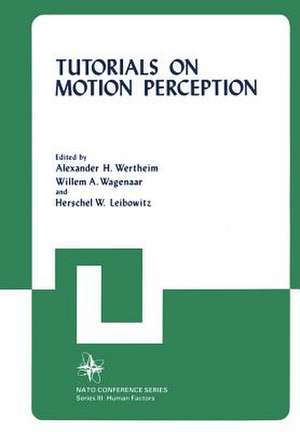Tutorials on Motion Perception: Nato Conference Series, cartea 20
Editat de Alexander H. Wertheimen Limba Engleză Paperback – 3 noi 2011
Din seria Nato Conference Series
- 5%
 Preț: 389.56 lei
Preț: 389.56 lei - 15%
 Preț: 705.99 lei
Preț: 705.99 lei - 15%
 Preț: 661.32 lei
Preț: 661.32 lei -
 Preț: 389.49 lei
Preț: 389.49 lei -
 Preț: 412.95 lei
Preț: 412.95 lei - 18%
 Preț: 1241.42 lei
Preț: 1241.42 lei -
 Preț: 409.69 lei
Preț: 409.69 lei - 20%
 Preț: 585.73 lei
Preț: 585.73 lei -
 Preț: 412.57 lei
Preț: 412.57 lei -
 Preț: 396.78 lei
Preț: 396.78 lei -
 Preț: 399.12 lei
Preț: 399.12 lei -
 Preț: 415.29 lei
Preț: 415.29 lei -
 Preț: 397.97 lei
Preț: 397.97 lei -
 Preț: 396.62 lei
Preț: 396.62 lei -
 Preț: 390.08 lei
Preț: 390.08 lei - 5%
 Preț: 378.07 lei
Preț: 378.07 lei - 18%
 Preț: 1235.57 lei
Preț: 1235.57 lei - 15%
 Preț: 495.26 lei
Preț: 495.26 lei -
 Preț: 392.37 lei
Preț: 392.37 lei -
 Preț: 413.15 lei
Preț: 413.15 lei -
 Preț: 404.67 lei
Preț: 404.67 lei -
 Preț: 396.40 lei
Preț: 396.40 lei - 15%
 Preț: 662.16 lei
Preț: 662.16 lei - 5%
 Preț: 722.69 lei
Preț: 722.69 lei - 15%
 Preț: 666.41 lei
Preț: 666.41 lei -
 Preț: 382.75 lei
Preț: 382.75 lei - 18%
 Preț: 822.01 lei
Preț: 822.01 lei -
 Preț: 401.57 lei
Preț: 401.57 lei -
 Preț: 403.91 lei
Preț: 403.91 lei -
 Preț: 404.67 lei
Preț: 404.67 lei -
 Preț: 403.15 lei
Preț: 403.15 lei -
 Preț: 411.42 lei
Preț: 411.42 lei -
 Preț: 440.71 lei
Preț: 440.71 lei -
 Preț: 408.63 lei
Preț: 408.63 lei - 15%
 Preț: 647.27 lei
Preț: 647.27 lei -
 Preț: 393.74 lei
Preț: 393.74 lei -
 Preț: 392.97 lei
Preț: 392.97 lei - 18%
 Preț: 1234.62 lei
Preț: 1234.62 lei -
 Preț: 412.95 lei
Preț: 412.95 lei -
 Preț: 390.46 lei
Preț: 390.46 lei -
 Preț: 405.66 lei
Preț: 405.66 lei - 15%
 Preț: 667.54 lei
Preț: 667.54 lei - 18%
 Preț: 1242.03 lei
Preț: 1242.03 lei - 18%
 Preț: 1225.62 lei
Preț: 1225.62 lei - 15%
 Preț: 679.00 lei
Preț: 679.00 lei -
 Preț: 401.03 lei
Preț: 401.03 lei -
 Preț: 399.12 lei
Preț: 399.12 lei -
 Preț: 413.15 lei
Preț: 413.15 lei
Preț: 389.70 lei
Nou
Puncte Express: 585
Preț estimativ în valută:
74.58€ • 80.98$ • 62.65£
74.58€ • 80.98$ • 62.65£
Carte tipărită la comandă
Livrare economică 22 aprilie-06 mai
Preluare comenzi: 021 569.72.76
Specificații
ISBN-13: 9781461335719
ISBN-10: 146133571X
Pagini: 284
Ilustrații: 263 p.
Dimensiuni: 170 x 244 x 15 mm
Greutate: 0.45 kg
Ediția:Softcover reprint of the original 1st ed. 1982
Editura: Springer Us
Colecția Springer
Seriile Nato Conference Series, III Human Factors
Locul publicării:New York, NY, United States
ISBN-10: 146133571X
Pagini: 284
Ilustrații: 263 p.
Dimensiuni: 170 x 244 x 15 mm
Greutate: 0.45 kg
Ediția:Softcover reprint of the original 1st ed. 1982
Editura: Springer Us
Colecția Springer
Seriile Nato Conference Series, III Human Factors
Locul publicării:New York, NY, United States
Public țintă
ResearchCuprins
Eye Movement and Motion Perception.- Summary.- 1. Three Stimuli for Motion Compared.- 2. Paths that Result from a Combination of Independent Motion Processes.- 3. Comparison of Three Stimuli for Motion Continued.- 4. Compensatory Eye Movement.- 5. Adaptation as Changed Evaluation of Compensatory Eye Movements.- References.- Visual Space Perception Through Motion.- Summary.- 1. Proximal Stimulus as an Optic Flow.- 2. About the Perceptual Vector Analysis as Demonstrated in Object Motion Research.- 3. About Perception of the Environment as a Fundamental Frame of Reference for Visual Perception.- 4. Concluding Remarks.- References.- Thresholds of Motion Perception.- 1. A Classification of Motion Displays.- 2. Assumptions and Processes in Motion Detection.- 3. Experimental Findings.- 4. Effects of Retinal Eccentricity.- 5. Conclusions.- Acknowledgement.- References.- Psychophysics of Motion Perception.- Summary.- 1. Stimuli and Dependent Measures.- 2. Elements of a Model.- 3. Extensions to the Simple Model.- 4. Studies of Stimulus Uncertainty.- References.- Visual Localization and Eye Movements.- 1. Introduction.- 2. Theories of Perceptual Stability.- 3. Localization with Steady Gaze.- 4. On Separating Visual Localization from Sensory/Motor Localization.- 5. Localization in the Presence of Saccadic Eye Movements.- 6. Concluding Remarks.- Footnotes.- References.- Linear Self Motion Peception.- 1. Role of the Otoliths in Linear Self Motion Perception.- 2. Models of Linear Motion Perception of Otolithic Origin.- 3. The Perception of Self Motion Induced by the Visual System.- 4. Visual Vestibular Interaction in Linear Self Motion Perception.- References.- Neural Substrates of the Visual Perception of Movement.- 1. Definitions.- 2. Criteria for Establishing the Neural Substratesof Movement Perception.- 3. Experimental Data.- 4. Conclusions.- Acknowledgements.- References.- Implications of Recent Developments in Dynamic Spatial Orientation and Visual Resolution for Vehicle Guidance.- 1. The Two Modes of Processing Concept.- 2. The Multisensory Nature of Spatial Orientation.- 3. Anomalous Myopias and The Intermediate Dark-Focus Ofaccommodation.- 4. Some Implications for Selection, Licensing, and Training.- References.





